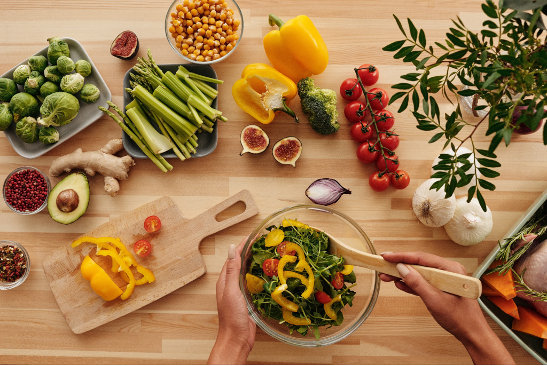2023 Food Trends and Impacts for Food Producers
go.ncsu.edu/readext?942522
en Español / em Português
El inglés es el idioma de control de esta página. En la medida en que haya algún conflicto entre la traducción al inglés y la traducción, el inglés prevalece.
Al hacer clic en el enlace de traducción se activa un servicio de traducción gratuito para convertir la página al español. Al igual que con cualquier traducción por Internet, la conversión no es sensible al contexto y puede que no traduzca el texto en su significado original. NC State Extension no garantiza la exactitud del texto traducido. Por favor, tenga en cuenta que algunas aplicaciones y/o servicios pueden no funcionar como se espera cuando se traducen.
Português
Inglês é o idioma de controle desta página. Na medida que haja algum conflito entre o texto original em Inglês e a tradução, o Inglês prevalece.
Ao clicar no link de tradução, um serviço gratuito de tradução será ativado para converter a página para o Português. Como em qualquer tradução pela internet, a conversão não é sensivel ao contexto e pode não ocorrer a tradução para o significado orginal. O serviço de Extensão da Carolina do Norte (NC State Extension) não garante a exatidão do texto traduzido. Por favor, observe que algumas funções ou serviços podem não funcionar como esperado após a tradução.
English
English is the controlling language of this page. To the extent there is any conflict between the English text and the translation, English controls.
Clicking on the translation link activates a free translation service to convert the page to Spanish. As with any Internet translation, the conversion is not context-sensitive and may not translate the text to its original meaning. NC State Extension does not guarantee the accuracy of the translated text. Please note that some applications and/or services may not function as expected when translated.
Collapse ▲Food is always a hot topic, as we all have to eat! Understanding our behavior toward food, what types and characteristics of food we are attracted to and how this ultimately impacts what we decide to grow or purchase, is an intriguing research topic to unpack. Food trends, or which foods are popular in restaurants, media channels, and amongst consumers at the time, are always changing. Foods that are stars one year could fizzle out into smoldering embers the following year, or they could continue to light the food scene and keep their popularity status for decades. Today we will digest what factors influence food trends, what are the current food trends in 2023, and how our food producing neighbors can ride these waves of food intrigue to best support their farms and food businesses.
Factors and Drivers of Food Trends
Food trends are integrated with our food systems, which includes all the steps food takes from farm to fork (and even after as food waste). Farmers sell specific ingredients to chefs and retailers who highlight those foods on their menus and in their stores; in turn, chefs and retailers inform farmers what ingredients they want to use based on consumer interest and sales. Retailers and farmers also work with manufacturers to make products that consumers are interested in to sell at their farm stands and shops. Various factors contribute to food trends, including content from influential people like chefs, nutritionists, and influencers on social media, but also current national and global events (ex. inflated food prices, pandemics, etc.), the environment (ex. climate change), and individual factors like age, income, ethnicity, and lifestyle.
to use based on consumer interest and sales. Retailers and farmers also work with manufacturers to make products that consumers are interested in to sell at their farm stands and shops. Various factors contribute to food trends, including content from influential people like chefs, nutritionists, and influencers on social media, but also current national and global events (ex. inflated food prices, pandemics, etc.), the environment (ex. climate change), and individual factors like age, income, ethnicity, and lifestyle.
Measuring consumer buying patterns over time can help determine which foods are being prioritized by consumers and how behaviors vary amongst different groups. Based on the 2023 Food and Health Survey from the International Food Information Council, the five most important factors driving food purchasing decisions amongst consumers are taste (87%), price (76%), healthfulness (62%), convenience (61%), and environmental sustainability (34%). The top label characteristics that appeal to consumers include “natural,” “organic,” “no added hormones or steroids,” and “locally-sourced.” Transparency in knowing where and how food is produced is of high interest, with mindfulness toward animal welfare and sustainability of packaging being especially prevalent amongst younger generations, especially Millennials and Gen X.
What are the Current Food Trends in 2023?
Based on consumer surveys, there are several different food trends circulating in 2023. The “plant-forward” eating style is gaining a lot of momentum, and includes treating plants as the stars in our dishes. This eating style promotes incorporating more plants into our diets, using plant-based protein sources like beans, lentils, and grains, and if meat is used, treating it more as a side dish alongside fruits and veggies, legumes, nuts and seeds, whole grains, and herbs and spices. This plant-forward eating style is also supported by research-based evidence to help promote health and environmental sustainability. Bold flavors are also popular, such as those found in pickled and fermented foods, as well as flavor combinations like “swicy,” which is a mix of spicy and sweet, and sour and umami flavors, found in foods like kimchi, kombucha, and miso. There is also increasing interest in foods made with chilis as well as ethnic cuisines, especially those from the Caribbean, Southeast Asia (ex. Vietnam, Singapore), and South America (ex. Brazil, Argentina). Ancient grains, or grains that have remained largely unchanged for over hundreds of years, are another trendy food group which are high in protein and fiber content and contain essential vitamins and minerals. Examples of commonly known ancient grains include pumpkin seeds, flax seeds, chia seeds, chickpeas, buckwheat, millet, and quinoa. There is also a pivot away from sugar and high fructose corn syrup and toward healthier sweeteners such as maple syrup, honey, fruit juices, and agave nectar.
How Food Trends and Consumer Spending Behaviors Can Benefit Food Producers
Local farms and food producers rely on consumers to sustain their businesses, and being aware of current food trends can be a great asset for developing effective marketing strategies. For our food producers out there, it is important to define your target consumer base and understand what food characteristics and values they are most attracted to. Once you have done that research, make the most of your packaging through effective design and labeling (ex. certifications, regional labels) to offer clear messaging to consumers and highlight key features of your products. Lastly, be flexible with your product portfolio and strategies and be willing to spice up your packaging and accessibility to match your target consumers’ preferences and lifestyles, as these will change over time.
For more information on food trends and how local food producers can benefit from using this information to grow their businesses, please contact N.C. Cooperative Extension, Lee County Center office and ask for Meredith Favre, our Local Foods Coordinator, for more information.




